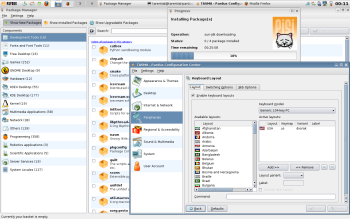Author: Preston St. Pierre
Pardus is a GNU/Linux distribution funded and developed by the Scientific and Technological Research Council of Turkey. Pardus has its own unique installer, package manager, configuration wizard, and control panel. This originality, and the developers’ attention to detail, make Pardus worth a look.
From the beginning of my experience, Pardus showed its attention to detail. The installer is so incredibly simple that even a Microsoft fan would be hard-pressed to complain. The installer hasn’t changed much since we took a look at the previous release seven months ago, so I won’t reiterate the process, but it’s still worth mentioning how easy to use the installer is. My only complaint is that my choice of Dvorak for keyboard layout was not available as an option.
After the install and subsequent reboot, Kaptan, the initial desktop configuration wizard, appears onscreen to allow you to set up options such as background image and menu orientation, as well as your network. Like the installer, this wizard is easy to use and understand.
After Kaptan finished I ran Tasma, the Pardus configuration center. For the most part, it presented a friendly and intuitive layout for changing system options. The main problem I encountered was that when I selected “Canada” as my region, it set the language to French. Perhaps it’s a bug, or perhaps the Pardus team doesn’t know, but the majority of Canadians speak English as a first language. However, this was a minor issue and easily fixed. As an added bonus, Tasma let me select Dvorak as my keyboard layout.
I quickly discovered that Pardus includes all the “goodies” that distro developers sometimes avoid for legal reasons. Codecs for all my movies are included, as well as Adobe Flash and Java. In contrast to the way it behaves in many other distributions, the Flash plugin for Firefox actually played sound for me without additional configuration. To top it all off, DVDs played without a hitch. These multimedia features may not be essential parts of the system, but they can be huge annoyances when missing. It was not all fun and games, though: the Flash plugin seems to have crashed Firefox on a number of occasions when I was viewing Flash-enabled sites. The crashes stopped when I disabled Flash.
The default packages included with Pardus cover most major needs. Included are the GIMP and KolourPaint for image manipulation, Gwenview for image viewing, digiKam) for digital camera management, and Kooka for scanner management. For office needs, OpenOffice.org is included, along with various complementary KDE packages (Kontact, Karm, Kalarm, Knotes, and Kpilot, to name a few). Multimedia is well covered, with Amarok, JuK for listening to music, MPlayer and Kaffeine for watching movies, K3b and KaudioCreator for burning and ripping CDs and DVDs, and krecord for recording audio. Internet applications include Kopete for instant messaging, Konversation for IRC, Firefox and Konqueror for Web browsing, KMail, KFTPGrabber, KTorrent, and even Usenet news reader KNode. Most of these applications have been updated since the previous Pardus release, and several are the current stable versions.
While for most people the default programs may be enough, Pardus has its own package manager, called PiSi, and its own repository of packages in case you need something else. Currently there are about 1,200 packages available for install — a respectable amount. However, since the Pardus repository can’t compare to the Debian repository in size (and even that is not complete), I found a few applications and libraries not available through PiSi (such as Video4Linux Grab) which I had to build from source. The regular development tools aren’t included with Pardus, but they are available for install through PiSi, which makes it a trivial task to build other applications from source. While it might be nice if more applications were packaged and offered through PiSi, it is easy to see that the workload involved in maintaining all those packages could overwhelm available resources. Given that, I think it’s amazing how many packages are already available, and how up-to-date they are. With time and more users, the Pardus repositories will doubtlessly grow, and from what I’ve experienced of Pardus it looks like it will soon have more users.
The one truly bothersome bug I encountered was that after every reboot the number of virtual desktops in KDE returned to two. I like to have that number set at eight, and I had to redo this process at every boot. Although this is easy to change, it is an annoyance in an otherwise exceptional distribution. The other problems I encountered were temporary, as in the case of the use of French for the Canadian region, or likely the fault of the Pardus team, such as Flash crashing Firefox. The advantages of using Pardus (easy install and configuration, simple and reliable package manager, proper detection of my hardware, and a nice selection of applications installed by default) outweigh the few minor bugs by quite a bit.
My experience with Pardus was quite positive. The attention to detail, right down to skinning Amarok with the Pardus colors, is matched by the elegance of the installer and the efficacy of Kaptan and PiSi. Booting and running Pardus is quite speedy on my old AMD Sempron 2800+ with 512MB RAM; other distributions with similar features (such as Ubuntu) run slower on the same hardware. In short, I think Pardus is a distribution worth looking at for any Linux users who aren’t happy with their current choice.
Categories:
- Pardus
- Reviews
- Linux
- Distributions



